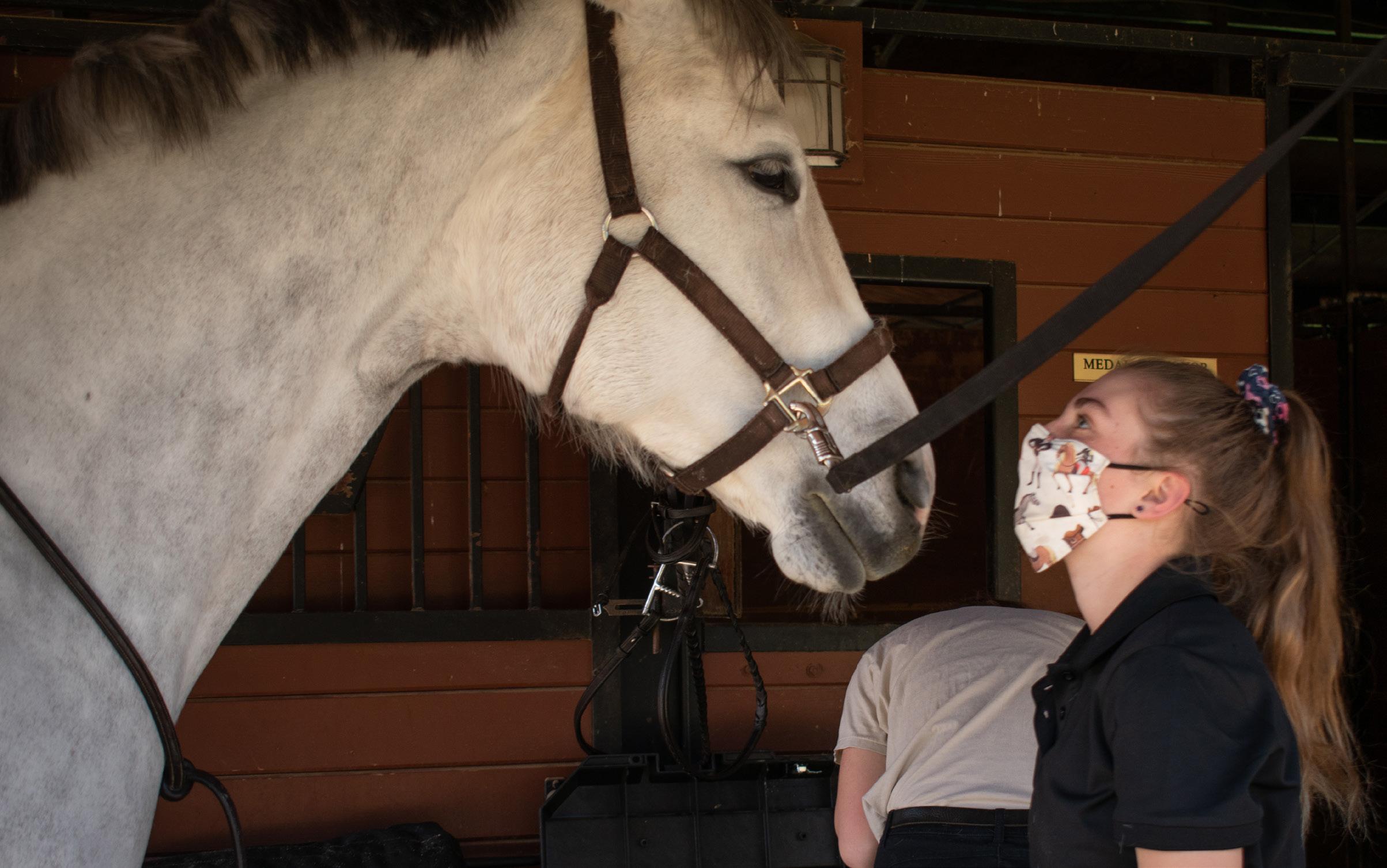
5 minute read
it’S bEEN my SAviOR iN A WAy
How Emily Heery became an equestrian
Advertisement
ARTICLE & DESIGN BY JENNA PLASSCHAERT • PHOTOS BY TYLER YUEN
Emily Heery (11) and her horse, Bella, jump over a fence during practice at Glenoaks Equestrian Center on March 21. Prior to jumping, Heery warmed up by riding around the ring with friends.
Junior Emily Heery rode her first horse on a Girl Scouts trip in third grade, but it was not until her sister Caitlin went on that same trip two years later that their mom decided to put Emily in horse riding lessons and her love for riding truly blossomed.
“Looking back, I don’t really know what drew me to it specifically,” Heery said. “I think it just came really naturally to me in the beginning, and it just made sense. Horses are such sweet animals; they’ll take care of you. So I think that finding the bond between this really big animal and a human is just beautiful.”
Starting with 30-minute private lessons once a week at Spring Down Equestrian Center in Portola Valley, Heery began to learn basic aids—signals given to the horse with hands, legs, voice and weight— such as steering, stopping and starting. After a couple months, she eventually moved on and followed her former trainer, Sarah Morgan, to Webb Ranch.
“[Sarah] helped me a lot in developing not just being a ‘potted plant,’ so to speak, on the horse, but actually learning how to use my aids that I learned as a younger and inexperienced rider to be more connected with the horse,” Heery said.
As she evolved in riding, Heery was able to learn more advanced aids such as collection, which allows the horse to be more balanced and fluid.
“A lot of people think it’s the horse that does the work for you,” Heery said. “I mean, up to a certain point, they are the one who jumps over the rail, but you have to help them.”
Heery decided Webb Ranch was not a good fit for her because it was often busy and crowded. In mid-January of 2020, she switched to her current trainer, Cindy Kuhn, at Glenoaks Equestrian Center and joined Kuhn’s team, Lake Forest Farms.
“It’s a really pretty facility; I really like it,” Heery said. “The more calm environment is really nice because I am able to focus and not necessarily have to worry about everything else going on in the arena at the time.”
Typically, Heery visits the barn six days a week, reserving Wednesdays to stay on top of her AP Calculus AB work. She primarily focuses on jumping

Heery begins putting the necessary equipment and accessories on her horse and getting her horse ready—known as tacking up—before her practice begins on March 21. The process takes approximately 20 minutes total. two to three times a week and flatwork on the other days, which involves all the ground exercises a horse does while being ridden as opposed to over jumps, including circles, turns and trotting.
Of the several disciplines in horseback riding, Heery decided to enter the jumping division after riding school because she felt like it came most naturally to her and was more of an even playing field than other divisions, such as the hunters division which requires a more expensive and attractive horse.
Hunters are judged based on the movement and style of the horse, while jumpers are judged solely on the speed at which they finish the course, losing points for each rail knocked over during a jump.
“Because I’m a jumper, as we get closer to a show, I’ll do a lot more jumps and I’ll begin to focus on cutting my corners to cut the time off,” Heery said. “The smaller your turn, the better your turn, the clearer your turn, the quicker your time.”
After joining Glenoaks Equestrian Center, Heery was able to buy her own horse, a gray mare named Bella, which she believes allowed herself to take charge of her riding and make decisions for the horse rather than having the horse make decisions for her. “It’s so ironic because 2020 was such a bad year,” Heery said, “but I also find it one of the best years because it was a big step in my riding, and [Bella has] helped me so much.”
According to COVID-19 lockdown rules, only those who had leased or bought a horse were allowed to visit the barn. At that time, Heery was leasing her trainer’s horse, Beau, until she bought Bella on July 4, and was therefore able to continue her riding practices throughout quarantine. Since then, COVID-19 protocols have changed and the lesson barn has reopened to the public with a mask mandate.
Riding has provided Heery with an outlet to express herself and get out of her room during quarantine, benefiting her mental health.
“I think [riding has] been my savior in a way,” Heery said. “I’m able to get out and enjoy something that I do like. I think in terms of anything that you really love doing, it’s almost like an escape.”
Heery’s social life has also been positively impacted through making friends at the barn and being able to work over the summer teaching children the basics of riding.
“I’m with two or three different groups of kids that rotate,” Heery said. “It’s nice because they learn more independently, which I think is really helpful.”
This summer, Heery hopes to continue working to teach her students valuable life skills, such as thinking through their actions, and inspire a love of riding in her students that she continues to experience.
“I enjoy the jumping in the courses because it’s almost freeing,” Heery said. “You see those horse movies and they’re galloping down a meadow and that’s what it feels like. It’s this happy feeling.”




